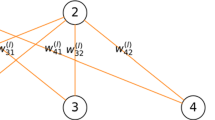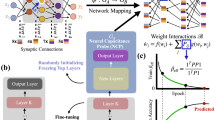Abstract
While deep neural networks are highly effective at solving complex tasks, large pre-trained models are commonly employed even to solve consistently simpler downstream tasks, which do not necessarily require a large model’s complexity. Motivated by the awareness of the ever-growing AI environmental impact, we propose an efficiency strategy that leverages prior knowledge transferred by large models. Simple but effective, we propose a method relying on an Entropy-bASed Importance mEtRic (EASIER) to reduce the depth of over-parametrized deep neural networks, which alleviates their computational burden. We assess the effectiveness of our method on traditional image classification setups. Our code is available at https://github.com/VGCQ/EASIER.
Access this chapter
Tax calculation will be finalised at checkout
Purchases are for personal use only
Similar content being viewed by others
Notes
- 1.
Few exceptions to this exist, like LeakyReLU. In those occurrences, even though the activation will not converge to zero, we still choose to call it OFF state as, given the same input’s magnitude, the magnitude of the output is lower.
- 2.
Please be aware that additional sum and average over the entire feature map generated per input are required for convolutional layers.
- 3.
The code and the Appendix are available at https://github.com/VGCQ/EASIER.
References
Jaafra, Y., Laurent, J.L., Deruyver, A., Naceur, M.S.: Reinforcement learning for neural architecture search: a review. Image Vis. Comput. 89, 57–66 (2019)
Ali Mehmeti-Göpel, C.H., Disselhoff, J.: Nonlinear advantage: trained networks might not be as complex as you think. In: ICML. PMLR (2023)
Baymurzina, D., Golikov, E., Burtsev, M.: A review of neural architecture search. Neurocomputing 474, 82–93 (2022)
Blalock, D., Gonzalez Ortiz, J.J., Frankle, J., Guttag, J.: What is the state of neural network pruning? In: MLSys (2020)
Bragagnolo, A., Tartaglione, E., Fiandrotti, A., Grangetto, M.: On the role of structured pruning for neural network compression. In: ICIP. IEEE (2021)
Brown, T., et al.: Language models are few-shot learners. In: NeurIPS (2020)
Cai, H., Gan, C., Wang, T., Zhang, Z., Han, S.: Once-for-all: train one network and specialize it for efficient deployment. In: ICLR (2019)
Castillo-Navarro, J., Le Saux, B., Boulch, A., Lefèvre, S.: On auxiliary losses for semi-supervised semantic segmentation. In: ECML PKDD (2020)
Cho, M., Joshi, A., Reagen, B., Garg, S., Hegde, C.: Selective network linearization for efficient private inference. In: ICML. PMLR (2022)
Cimpoi, M., Maji, S., Kokkinos, I., Mohamed, S., Vedaldi, A.: Describing textures in the wild. In: CVPR (2014)
Craig, C.C.: On the frequency function of \(xy\). Ann. Math. Stat. 7, 1–15 (1936)
Cui, G., Yu, X., Iommelli, S., Kong, L.: Exact distribution for the product of two correlated Gaussian random variables. IEEE Signal Process. Lett. 23(11), 1662–1666 (2016)
Dror, A.B., Zehngut, N., Raviv, A., Artyomov, E., Vitek, R., Jevnisek, R.: Layer folding: neural network depth reduction using activation linearization. In: BMVC (2022)
Faiz, A., et al.: LLMCarbon: modeling the end-to-end carbon footprint of large language models. In: ICLR (2023)
Gale, T., Elsen, E., Hooker, S.: The state of sparsity in deep neural networks. arXiv preprint arXiv:1902.09574 (2019)
Gulrajani, I., Lopez-Paz, D.: In search of lost domain generalization. In: ICLR (2020)
Guo, J., et al.: CMT: convolutional neural networks meet vision transformers. In: CVPR (2022)
Han, S., Pool, J., Tran, J., Dally, W.: Learning both weights and connections for efficient neural network. In: NeurIPS. Curran Associates, Inc. (2015)
He, K., Zhang, X., Ren, S., Sun, J.: Deep residual learning for image recognition. In: CVPR (2016)
He, Y., Xiao, L.: Structured pruning for deep convolutional neural networks: a survey. IEEE Trans. Pattern Anal. Mach. Intell 46(5), 2900–2919 (2023)
Hestness, J., et al.: Deep learning scaling is predictable, empirically. arXiv preprint arXiv:1712.00409 (2017)
Hinton, G., Vinyals, O., Dean, J.: Distilling the knowledge in a neural network. arXiv preprint arXiv:1503.02531 (2015)
Howard, A.G., et al.: MobileNets: efficient convolutional neural networks for mobile vision applications. arXiv preprint arXiv:1704.04861 (2017)
Jha, N.K., Ghodsi, Z., Garg, S., Reagen, B.: DeepReDuce: ReLU reduction for fast private inference. In: ICML. PMLR (2021)
Krizhevsky, A., Hinton, G., et al.: Learning multiple layers of features from tiny images (2009)
Kuang, W., Zhu, Q., Li, Z.: Multi-label image classification with multi-scale global-local semantic graph network. In: Koutra, D., Plant, C., Gomez Rodriguez, M., Baralis, E., Bonchi, F. (eds.) Machine Learning and Knowledge Discovery in Databases: Research Track, ECML PKDD 2023. LNCS, vol. 14171, pp. 53–69. Springer, Cham (2023). https://doi.org/10.1007/978-3-031-43418-1_4
Le, Y., Yang, X.: Tiny ImageNet visual recognition challenge. CS 231N 7, 3 (2015)
Lee, N., Ajanthan, T., Torr, P.: SNIP: single-shot network pruning based on connection sensitivity. In: ICLR (2019)
Liao, Z., Quétu, V., Nguyen, V.T., Tartaglione, E.: Can unstructured pruning reduce the depth in deep neural networks? In: ICCV (2023)
Liu, H., Simonyan, K., Yang, Y.: DARTS: differentiable architecture search. In: ICLR (2018)
Liu, Z., et al.: Swin transformer: hierarchical vision transformer using shifted windows. In: ICCV (2021)
Louizos, C., Welling, M., Kingma, D.P.: Learning sparse neural networks through \(l_0\) regularization. In: ICLR (2018)
Maji, S., Kannala, J., Rahtu, E., Blaschko, M., Vedaldi, A.: Fine-grained visual classification of aircraft. Technical report (2013)
Mouret, J.B., Clune, J.: Illuminating search spaces by mapping elites. arXiv preprint arXiv:1504.04909 (2015)
Nilsback, M.E., Zisserman, A.: Automated flower classification over a large number of classes. In: Indian Conference on Computer Vision, Graphics and Image Processing, December 2008
Quétu, V., Tartaglione, E.: DSD\(^2\): can we dodge sparse double descent and compress the neural network worry-free? In: AAAI (2024)
Rastegari, M., Ordonez, V., Redmon, J., Farhadi, A.: XNOR-Net: ImageNet classification using binary convolutional neural networks. In: Leibe, B., Matas, J., Sebe, N., Welling, M. (eds.) ECCV 2016. LNCS, vol. 9908, pp. 525–542. Springer, Cham (2016). https://doi.org/10.1007/978-3-319-46493-0_32
Real, E., et al.: Large-scale evolution of image classifiers. In: ICML. PMLR (2017)
Seijas-Macías, A., Oliveira, A.: An approach to distribution of the product of two normal variables. Discussiones Mathematicae Probab. Stat. 32, 87–99 (2012)
Simonyan, K., Zisserman, A.: Very deep convolutional networks for large-scale image recognition. In: ICLR (2015)
Sun, D., Wang, M., Li, A.: A multimodal deep neural network for human breast cancer prognosis prediction by integrating multi-dimensional data. IEEE/ACM Trans. Comput. Biol. Bioinform. (2019)
Tanaka, H., Kunin, D., Yamins, D.L., Ganguli, S.: Pruning neural networks without any data by iteratively conserving synaptic flow. In: NeurIPS (2020)
Tartaglione, E., Bragagnolo, A., Fiandrotti, A., Grangetto, M.: Loss-based sensitivity regularization: towards deep sparse neural networks. Neural Netw. 146, 230–237 (2022)
Tartaglione, E., Bragagnolo, A., Odierna, F., Fiandrotti, A., Grangetto, M.: SeReNe: sensitivity-based regularization of neurons for structured sparsity in neural networks. IEEE Trans. Neural Netw. Learn. Syst. 33(12), 7237–7250 (2021)
Touvron, H., et al.: LLaMA: open and efficient foundation language models. arXiv preprint arXiv:2302.13971 (2023)
Wang, R., Cheng, M., Chen, X., Tang, X., Hsieh, C.J.: Rethinking architecture selection in differentiable NAS. In: ICLR (2020)
Yang, Y., Li, M., Meng, B., Huang, Z., Ren, J., Sun, D.: Rethinking the misalignment problem in dense object detection. In: Amini, M.R., Canu, S., Fischer, A., Guns, T., Kralj Novak, P., Tsoumakas, G. (eds.) Machine Learning and Knowledge Discovery in Databases, ECML PKDD 2022. LNCS, vol. 13715, pp. 427–442. Springer, Cham (2023). https://doi.org/10.1007/978-3-031-26409-2_26
Zhu, M.H., Gupta, S.: To prune, or not to prune: exploring the efficacy of pruning for model compression (2018)
Zoph, B., Le, Q.: Neural architecture search with reinforcement learning. In: ICLR (2016)
Acknowledgments
This project has received funding from the European Union’s Horizon Europe research and innovation programme under grant agreement 101120237 (ELIAS). Also, this research was partially funded by Hi!PARIS Center on Data Analytics and Artificial Intelligence. This project was provided with computer and storage resources by GENCI at IDRIS thanks to the grant 2023-AD011013930R1 on the supercomputer Jean Zay’s the V100 partition.
Author information
Authors and Affiliations
Corresponding author
Editor information
Editors and Affiliations
1 Electronic supplementary material
Below is the link to the electronic supplementary material.
Rights and permissions
Copyright information
© 2024 The Author(s), under exclusive license to Springer Nature Switzerland AG
About this paper
Cite this paper
Quétu, V., Liao, Z., Tartaglione, E. (2024). The Simpler The Better: An Entropy-Based Importance Metric to Reduce Neural Networks’ Depth. In: Bifet, A., Davis, J., Krilavičius, T., Kull, M., Ntoutsi, E., Žliobaitė, I. (eds) Machine Learning and Knowledge Discovery in Databases. Research Track. ECML PKDD 2024. Lecture Notes in Computer Science(), vol 14946. Springer, Cham. https://doi.org/10.1007/978-3-031-70365-2_6
Download citation
DOI: https://doi.org/10.1007/978-3-031-70365-2_6
Published:
Publisher Name: Springer, Cham
Print ISBN: 978-3-031-70364-5
Online ISBN: 978-3-031-70365-2
eBook Packages: Computer ScienceComputer Science (R0)





